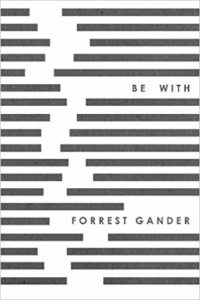
The 2019 Pulitzer Prize for Poetry was awarded to the collection Be With by Forrest Gander. It’s one of the most unusual collections of poetry I’ve ever encountered; I’ve read it three times now and each time it seems a different book.
Be With is a collection of different kinds and forms of poetry. It is less a collection of poems than it is meditations upon the personal and the intimate, even when it talks about things that’s aren’t personal or intimate. It is a collection of poetry that is about the beauty of language, and how beauty and language can be used to describe and evoke profoundly deep feelings.
The collection officially contains 18 poems. Many of those poems are themselves collections of poems that could easily stand on their own. But grouped together, they become poems telling stories — of caring for an aging mother, of chasing personal demons, of a love relationship, of a border crossing (mostly illegal), and of interpreting a series of black-and-white photographs.
And then I wonder if Be With is a fourth book — a kind of beauty-studded guidebook.
Come with Gander to Tuscany, as he considers the Madonna del Parto. Fairly common in 14th century Italy (there’s even a museum that focuses on it), a Madonna del Parto is a depiction of the pregnant Virgin Mary. Painted by many artists, this portrayal of Mary was associated with prayers for safe delivery of a child. Knowing that, consider what Gander does with it.
Madonna Del Parto

feeling it before
the sound even reaches
him, he kneels at
cliff’s edge and for the
first time, turns his
head toward the now
visible falls that
gush over a quarter
mile of uplifted sheet-
granite across the valley
and he pauses,
lowering his eyes
for a moment, unable
to withstand the
tranquility—vast, unencumbered,
terrifying, and primal. That
naked river
enthroned upon
the massif altar,
bowed cypresses
congregating on both
sides of sun-gleaming rock, a rip
in the fabric of the ongoing
forest from which rises—
as he tries to stand, tottering, half-
paralyzed—a shifting
rainbow volatilized by
ceaseless explosion.

Forrest Gander
Holding degrees in geology and English literature, Gander is the A.K. Seaver Professor of Literary Arts and Comparative Literature at Brown University. He’s received grants from the National Endowment for the Arts, the Guggenheim Foundation, the Howard Foundation, the Witter Bynner Foundation, and the Whiting Foundation. He’s written numerous collections of poetry, translations (including Then Come Back: The Lost Neruda Poems), essays, and fiction, including two novels, As a Friend (2008) and The Trace (2015). Gander was a finalist for the Pulitzer Prize for Poetry in 2012 for his collection Core Samples from the World and has previously been longlisted for the National Book Award.
Be With is a quietly stunning work, with something to stimulate reflection and introspection on every page and in every poem. These poems are written with a full understanding of how language can be used to plumb our interior depths. It’s as inspirational as it is unsettling.
Related:
Forrest Gander reads his poem “Madonna Del Parto”
Photo by Gabriel Rojas Hruska, Creative Commons, via Flickr. Post by Glynn Young.
__________________________

“I require all our incoming poetry students—in the MFA I direct—to buy and read this book.”
—Jeanetta Calhoun Mish
- Poets and Fables: Steven Flint and “The Sun and the Boy” - July 3, 2025
- Poets and Poems: Alison Blevins and “Where Will We Live if the House Burns Down?” - July 1, 2025
- Poets and Poems: Paul Pastor and “The Locust Years” - June 26, 2025
Bethany R. says
Sounds fascinating, thanks for this post. Some years back, Forrest Gander wrote the first sonnet I claimed as a favorite. It was called, “Voiced Stops.” It’d be interesting to read this new collection as well.